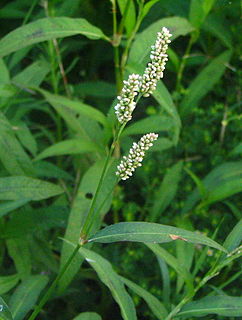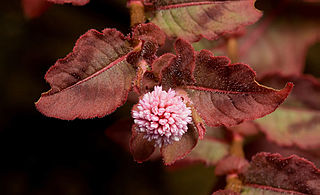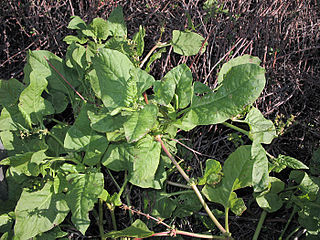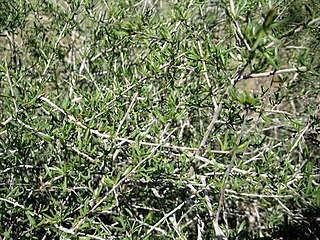
The Polygonaceae are a family of flowering plants known informally as the knotweed family or smartweed—buckwheat family in the United States. The name is based on the genus Polygonum, and was first used by Antoine Laurent de Jussieu in 1789 in his book, Genera Plantarum. The name may refer to the many swollen nodes the stems of some species have, being derived from Greek, poly meaning 'many' and gony meaning 'knee' or 'joint'. Alternatively, it may have a different derivation, meaning 'many seeds'.

Persicaria is a genus of herbaceous flowering plants in the knotweed family, Polygonaceae. Plants of the genus are known commonly as knotweeds or smartweeds. It has a cosmopolitan distribution, with species occurring nearly worldwide. The genus was segregated from Polygonum.

The genus Fagopyrum is in the flowering plant family Polygonaceae. It includes some important food plants, such as F. esculentum (buckwheat) and F. tataricum. The genus is native to the Indian subcontinent, much of Indochina, and central and southeastern China. Species have been widely introduced elsewhere, throughout the Holarctic and parts of Africa and South America.

Polygonum is a genus of about 130 species of flowering plant in the buckwheat and knotweed family Polygonaceae. Common names include knotweed and knotgrass. In the Middle English glossary of herbs Alphita, it was known as ars-smerte. There have been various opinions about how broadly the genus should be defined. For example, buckwheat has sometimes been included in the genus as Polygonum fagopyrum. Former genera such as Polygonella have been subsumed into Polygonum; other genera have been split off.

Fallopia is a genus of about 12 species of flowering plants in the buckwheat family, often included in a wider treatment of the related genus Polygonum in the past, and previously including Reynoutria. The genus is native to temperate and subtropical regions of the Northern Hemisphere, but species have been introduced elsewhere. The genus includes species forming vines and shrubs.

Muehlenbeckia or maidenhair is a genus of flowering plants in the family Polygonaceae. It is native to the borders of the Pacific, including South and North America, Papua New Guinea and Australasia. It has been introduced elsewhere, including Europe. Species vary in their growth habits, many being vines or shrubs. In some environments, rampant species can become weedy and difficult to eradicate.

Rheum is a genus of about 60 herbaceous perennial plants in the family Polygonaceae. Species are native to eastern Europe, southern and eastern temperate Asia, with a few reaching into northern tropical Asia. Rheum is cultivated in Europe and North America. The genus includes the vegetable rhubarb. The species have large somewhat triangular shaped leaves with long, fleshy petioles. The flowers are small, greenish-white to rose-red, and grouped in large compound leafy inflorescences. A number of cultivars of rhubarb have been domesticated both as medicinal plants and for human consumption. While the leaves are slightly toxic, the stalks are used in pies and other foods for their tart flavor.

Rumex spinosus, commonly known as devil's thorn or lesser jack, is an annual herbaceous plant of the Polygonaceae. It originates in the warmer parts of the old world, but now has spread with humans to other places. It is common in disturbed areas, especially in sandy soils. It has shown some weedy behaviour in restricted areas within southern Australia.

Pteropyrum is a genus of plants in the family Polygonaceae. Plants of the World Online accepts two species, native to Iran, Oman and the Gulf States.

Oxyria is a genus of plants in the family Polygonaceae with three accepted species as of March 2019. It has a circumboreal distribution.

Oxygonum is a genus of plants in the family Polygonaceae with about 30 species. It is native to eastern parts of Africa and to the Arabian Peninsula.

Koenigia is a genus of plants in the family Polygonaceae. The genus Aconogonon has been merged into Koenigia.
Knorringia sibirica is a species of flowering plant in the family Polygonaceae, native to Siberia to Korea. It was first described, as Polygonum sibiricum by Erik Laxmann in 1773, and transferred to Knorringia by Nikolai Tzvelev in 1987.

Atraphaxis is a genus of flowering plants in the family Polygonaceae with about 40 species.

Bistorta is a genus of flowering plants in the family Polygonaceae. As of February 2019 about 40 species are accepted. It has been supported as a separate clade by molecular phylogenetic analysis. Bistorta species are native throughout much of the Northern Hemisphere, as far south as Mexico in North America and Thailand in Asia.

Pteroxygonum is a plant genus in the family Polygonaceae. As of March 2019, two species are recognized. Their native range is from Tibet to southeast China.
Polygonum smallianum is a species of flowering plant in the knotweed family known by the common name largeleaf jointweed. It is native to a small area around the border between Alabama and Florida in the United States.

Reynoutria is a genus of flowering plants in the family Polygonaceae. The genus is native to eastern China, Eastern Asia and the Russian Far East, although species have been introduced to Europe and North America. Members of the genus, including R. japonica and its hybrid with R. sachalinensis, are highly invasive plants.

Polygonoideae is a subfamily of plants in the family Polygonaceae. It includes a number of plants that can be highly invasive, such as Japanese knotweed, Reynoutria japonica, and its hybrid with R. sachalinensis, R. × bohemica. Boundaries between the genera placed in the subfamily and their relationships have long been problematic, but a series of molecular phylogenetic studies have clarified some of them, resulting in the division of the subfamily into seven tribes.

Duma is a genus of shrubby flowering plants in the family Polygonaceae, subfamily Polygonoideae. The genus was separated from Muehlenbeckia in 2011. The native range of the genus is Australia.

















